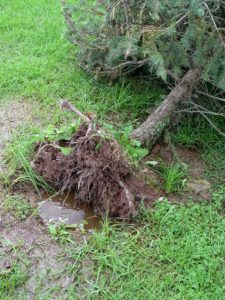What a Dead Plant Can Teach Us
August 30th, 2022
A plant dies, and the pessimist says, “There goes another one! Me and my black thumb should just quit.”

What lessons might these two browning arborvitae trying to teach?
A plant dies, and the optimist says, “If I can figure out what killed it, my next try is sure to thrive!”
I must be an optimist (at least when it comes to gardening) because I’ve always accepted dead plants 1.) as an inevitable part of gardening, and 2.) a learning experience.
Dead plants can teach us a lot. But since dead plants don’t talk, it’s up to us to investigate what caused the demise.
If we can figure that out, it’ll not only make our second try more successful but make us better gardeners in general.
Sometimes it’s bad luck or a one-time fluke, such as a storm-ripped tree branch that flattens a new evergreen or a girdling death from an out-of-the-blue buck rub.
We didn’t do anything wrong, and a simple retry might be all that’s needed.
But most of the time, a demise is due to something about the site or the care (or lack thereof) or the particular plant you’ve picked for a particular site.
In the best scenario, the cause of death is obvious – for example, a new shrub that’s turned brown after a month of drought and no watering by you.
The lesson is also obvious – if you pay more attention the next time (or are lucky enough to get better cooperation from rain), even the same plant in the same spot should do fine on try No. 2.
Since so many things can kill a plant, though, more often the cause of death takes closer examination.
You’ll probably need to wade through a series of checks and questions before being able to make an educated guess.
How’s the soil? Any sign of bug or disease damage on the foliage? Any sign of chewing damage to the bark? Was the plant wilting, looking washed out, or showing other signs of too much light before it croaked?

It’s pretty obvious from the water-filled hole that soggy soil was a problem here.
Granted, this isn’t easy, especially for the beginning gardener. There’s a lot to consider.
The good news is that with each passing plant death, the better you’ll get at informed guessing. Maybe you’ve heard the gardening riddle, “What’s the difference between a beginning gardener and an experienced gardener?” Answer: “The experienced gardener has killed way more plants.”
In the meantime, check out my post on “What’s Wrong with My Plant?” for help with your fledging plant-detective work.
With the lessons I’ve learned from dead plants over the years, I’ve found I’m much better now at guessing right on the first try than when I first started.
In other words, since I’ve seen Plant A revolt immediately in Site B, I know I’d better avoid a Site B-like site if I’m planning to plant a new Plant A-like plant.
I’m also more attuned to watching for early signs of trouble and taking action before it’s too late. Very often, moving or otherwise correcting a brewing threat is enough to save an otherwise doomed plant.
For more on that, check out my post on “Failure to Thrive.”
The flip side of this is that you can also learn from plants that are thriving.
When things are going well, evaluate what you did and what kind of plant is thriving in the spot you’ve planted it.
Then translate that elsewhere, i.e. plant more of the same kinds of things in the same kinds of places under the same kind of care.
In the meantime, try not to let the failures get you down.
As horticulturist Jimmy Turner once said, “The success of my garden is built on the compost of my failures.”







